List of ring galaxies
This is a list of ring galaxies. A ring galaxy, as the name suggests, is a disc or spiral galaxy with its galactic disc structured or distorted into a ring or torus-like appearance. Hoag's Object, discovered by Art Hoag in 1950, is the prototypical example of a ring galaxy. Ring galaxies are theorized to be formed through multiple possible situations-
1. Bar instability – a phenomenon where the rotational velocity of the bar in a barred spiral galaxy increases to the point of spiral spin-out. Under typical conditions, gravitational density waves would favor the creation of spiral arms. When bar instability occurs, these density waves are instead migrated out into a ring-structure by the pressure, force, and gravitational influence of the byronic and dark matter furiously orbiting about the bar. This migration forces the stars, gas and dust found within the former arms into a torus-like region, forming a ring, and often igniting star formation.
2. Galactic collisions- another observed way that ring galaxies can form is through the process of two or more galaxies colliding. The cartwheel galaxy, galaxy pair AM 2026-424, and Arp 147 are all examples of ring galaxies believed to be formed from this process. In pass-through galactic collisions, an often smaller galaxy will pass through the disc of an often larger spiral, causing an outward push of the arms, as if dropping a rock into a pond of still water. In side-swipe and head-on collisions, the appearance of a perfect ring are less likely, with chaotic and warped appearances dominating.
3. Intergalactic medium accretion- this method has been inferred through the existence of Hoags object, along with UV observations of several other large and ultra-large super spiral galaxies and current formation theories of spiral galaxies. UV-light observations show several cases of faint, ring-like and spiral structures of hot young stars that have formed along the network of cooled inflowing gas, extending far from the visible luminous galactic disc. If conditions are favorable, a ring can form in the place of a spiral structure. Since some spiral galaxies are theorized to have formed from massive clouds of intergalactic gas collapsing and then rotationally forming into a disc structure, one could assume that a ring disc could form in place of a spiral disc if, as mentioned before, conditions are favorable. This holds true for protogalaxies, or galaxies just throughout to be forming, and old galaxies that has migrated into a section of space with a higher gas content than its previous locations.
List
| Name | Image | Catalogue number | Distance | Notes |
|---|---|---|---|---|
| Cartwheel Galaxy |  |
ESO 350-40, PGC 2248 | 500 Mly | lenticular galaxy |
| NGC 6028 | 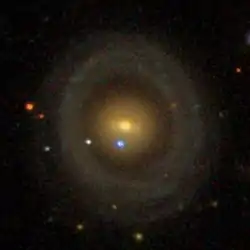 |
NGC 6028, NGC 6046, PGC 56716 | 203 Mly | barred lenticular galaxy |
| Hoag's Object | 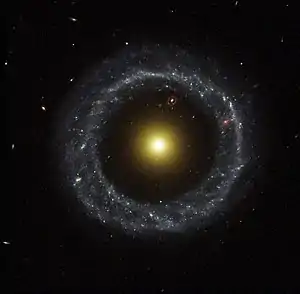 |
PGC 54559, PRC D-51 | 600 Mly | |
| SDSS J151713.93+213516.8 |  |
This galaxy can be seen behind Hoag's Object | ||
| AM 0644-741 | AM 0644-741 | 300 Mly | ||
| NGC 1291 | 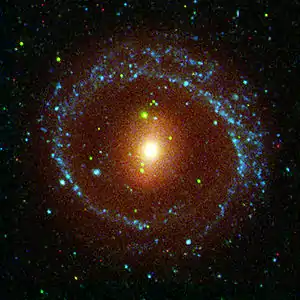 |
NGC 1291, NGC 1269,[1] PGC 012209 | 33 Mly | |
| NGC 1512 |  |
PGC 14391 | 38 Mly | Galaxy exhibits a double-ring structure |
| NGC 1433 | 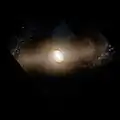 |
PGC 13586 | 49 Mly | barred spiral galaxy with ring |
| NGC 1533 | NGC 1533, PGC 14582[2] | 62 ± 4 Mly [3] | lenticular galaxy with ring structure | |
| NGC 2859 | 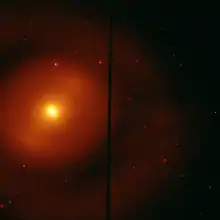 |
UGC 5001, PGC 26649 | 82.8 Mly | lenticular galaxy with ring structure[4] |
| NGC 1350 | PGC 013059 | 87.4 Mly | spiral galaxy with ring structure | |
| NGC 1386 | PGC 13333 | 53 Mly | spiral galaxy with ring structure | |
| NGC 1387 | 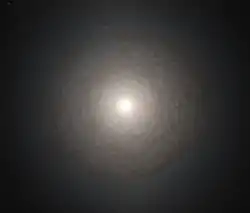 |
PGC 13344 | 53 Mly | lenticular galaxy with nuclear ring |
| NGC 4622 |  |
PGC 42701 | 200 Mly | unbarred spiral galaxy with ring |
| NGC 4777 | NGC 4777, PGC 43852 | |||
| NGC 7217 |  |
UGC 11914, PGC 68096 | 50 Mly | unbarred spiral galaxy with ring |
| II Zw 28[5] |  |
Zw II 28, 2MASX J05014205+0334278 | ||
| Mayall's Object | .jpg.webp) |
Arp 148, VV 032, MCG+07-23-019, APG 148 | 450 Mly | collisional ring galaxy |
| I Zw 045[6] | I Zw 045, NGC 4774 | collisional ring galaxy | ||
| VII Zw 466[6] | VII Zw 466, UGC 07683 | collisional ring galaxy | ||
| Arp 10[6] | Arp 10, UGC 01775, 2MASX J02182639+0539139[7] | collisional ring galaxy | ||
| Arp 147 | IC 298 | interacting pair | ||
| NGC 4650A | 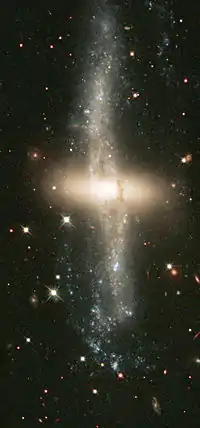 |
PGC 42951 | polar ring galaxy | |
| NGC 660 |  |
polar ring galaxy | ||
| NGC 922 | 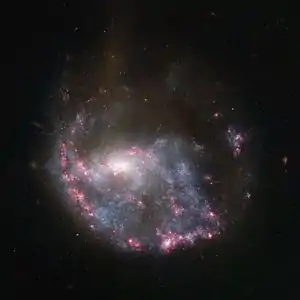 |
ESO 478-28, ISG 10 | 150 Mly | collisional ring galaxy |
| ESO 198-13 | 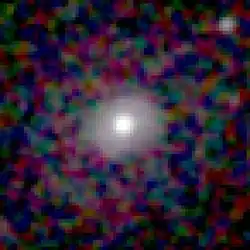 |
PGC 9463 | 240 Mly | three ring structures |
| LEDA 1000714 | 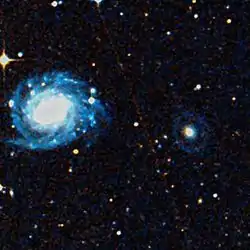 |
PGC 1000714, 6dFGS gJ112316.4-084007, 2MASX J11231643-0840067 | 360 Mly | two nearly round rings, but with different characteristics |
| NGC 985 | 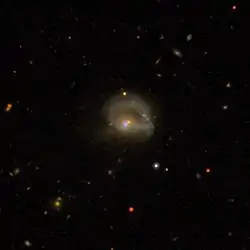 |
VV 285, Mrk 1048, MCG -02-07-035, PGC 9817 | 567 Mly | collisional ring galaxy |
| NGC 1142 | NGC 1144, UGC 2389, Arp 118, VV 331a, Mrk 1504, CGCG 389-046, MCG +00-08-048, PGC 11012 | 375 Mly | Seyfert galaxy | |
| NGC 3081 | IC 2529, ESO 499-G31, AM 0957-223, MCG -04-24-012, PGC 28876 | 83 Mly | barred lenticular galaxy | |
| NGC 3821 | 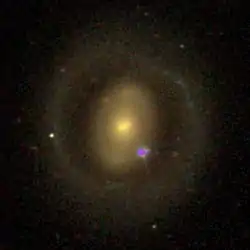 |
CGCG 127-32, MCG 4-28-30, PGC 36314, UGC 6663 | 271 Mly | low surface brightness galaxy |
| NGC 4513 |  |
CGCG 315-42, MCG 11-15-59, PGC 41527, UGC 7683 | 110 Mly | lenticular galaxy |
| NGC 7020 | 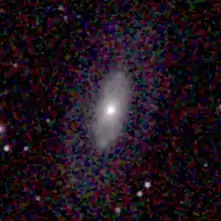 |
NGC 7021, ESO 107-13, PGC 66291 | 138 Mly | barred lenticular galaxy |
| NGC 7098 | 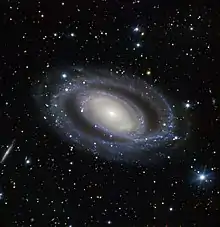 |
ESO 48-5, IRAS 21393-7520, PGC 67266 | 95 Mly | double barred spiral galaxy |
| NGC 7552 |  |
IC 5294, ESO 291- G 012, VV 440, PGC 70884 | 56 Mly | barred spiral galaxy |
| NGC 7742 | 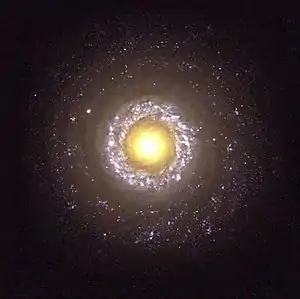 |
UGC 12760,[2] MCG +02-60-010,[2] UZC J234415.8+104601,[2] 2MASX J23441571+1046015 | 72 Mly | Unbarred spiral galaxy with ring, Seyfert galaxy |
See also
References
- "NGC 1291". Capella Observatory. 2005. Retrieved April 1, 2012.
- "Results for NGC 1533". NASA/IPAC Extragalactic Database. Retrieved 2008-06-26.
- Ryan-Weber, Emma; Webster, Rachel; Bekki, Kenji (April 2003). Jessica L. Rosenberg; Mary E. Putman (eds.). Galactic Recycling: The HI Ring Around NGC 1533. The IGM/Galaxy Connection: The Distribution of Baryons at Z=0, ASSL Conference Proceedings. 281. Dordrecht: Kluwer Academic Publishers. p. 223. arXiv:astro-ph/0209321. Bibcode:2003ASSL..281..223R. doi:10.1007/978-94-010-0115-1_40. ISBN 1-4020-1289-6. S2CID 16899046.
- "Lenticular Galaxy (NGC 2859)". Calvin College. Retrieved July 28, 2013.
- "Hubble Gazes on One Ring to Rule Them All". NASA. March 15, 2013. Retrieved July 28, 2013.
- Appleton, P. N.; Struck-Marcell, Curtis (1996). "Collisional Ring Galaxies". Fundamentals of Cosmic Physics. 16: 111–220. Bibcode:1996FCPh...16..111A. Retrieved July 29, 2013.
- "UGC 1775". SIMBAD. Centre de données astronomiques de Strasbourg. Retrieved July 29, 2013.